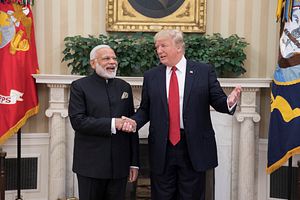Last week, U.S. President Donald Trump announced the 2019 Missile Defense Review (MDR), outlining the rapidly evolving threats and the U.S. measures and capabilities that are required to protect the homeland, bases abroad and U.S. allies and partners around the world. The document, the latest among a series of strategy documents released under the Trump administration, bears noting in terms of what it means for India and the wider Indo-Pacific.
The Indo-Pacific factors significantly in the MDR. There is a mention of threats such as North Korea, Iran, Russia, and China, the advancements in missile defense and anti-satellite (ASAT) advancements in a few countries that could negatively impact the United States, and references to the importance of working with U.S. allies and partners including Japan, South Korea, Australia, and India.
The references to these like-minded states in particular bears noting. Both Japan and South Korea are already working with the United States in developing their respective missile defense shields which are also “increasingly interoperable” with U.S. systems. Australia also plays an important role in strengthening the regional missile defense cooperation through a trilateral engagement with the United States and Japan. Where does India fit into this emerging missile defense partnership in the Indo-Pacific?
India is no stranger to this conversation: It has been trying to manage growing missile threats in its neighborhood for about two decades now. China-Pakistan collaboration in this regard has been a significant driver in pushing New Delhi in developing certain limited missile defense capabilities. In the early 1990s, proliferation of short- and medium-range ballistic missiles such as the M-9 and M-11 from China to Pakistan pushed India to explore missile defense options. India had learned to live with China’s inventory of long-range missiles, but Pakistan was always a more prominent and unpredictable rival for India, and thus India has felt compelled to respond with greater swiftness.
India’s missile defense options included both indigenously developing missile defense technology as well as procuring it from the outside. At the time, this effort represented a major shift in India’s policy on missile defenses: India had vociferously criticized the U.S. “Star Wars” missile defense programs of the 1980s. A changing missile threat perception along with a strategic reorientation toward the U.S. enabled these policy shifts in India.
In recognition of this fact, the MDR makes a pointed reference to the “advanced and diverse range of ballistic and cruise missile capabilities in South Asia.” The review further notes that this is a potential area of cooperation between India and the United States especially given the convergence of strategic interests between the two sides and sees this as “a natural outgrowth of India’s status as a Major Defense Partner and key element of our Indo-Pacific Strategy.”
There is certainly some indication of a greater weight being placed on India in Washington’s calculations about how it deals with U.S. alliances and partnerships in the region. To take just one example, the United States had, just a few months ago, granted India a “Strategic Trade Authorisation-1 (STA-1)” status, that was previously given only to Japan and South Korea in Asia. But in reality, though India has a growing interest in missile defenses, whether it will be able to partner with the United States is open to question.
For instance, interestingly, this comes in the backdrop of India’s decision to buy the Russian S-400 air defense system for $5 billion. The Indian decision to proceed with the S-400 systems is indicative of the scale of the missile threats in India’s neighborhood. But it also means it is unclear whether India will look to the United States for BMD systems: a U.S. and Russian defense system could be complicated in terms of interoperability, though some analysts argue that it is a sensible option to have different radars and different encryption systems to deal with an array of threats.
Another problem is that India’s DRDO is already developing its own two-tiered BMD system. In addition, at the lower end, India is purchasing the U.S.-Norwegian NASAMS-2 system, as well as the Indo-Israel MRSAM (a land version of the Barak-8 naval system). Given all this, whether or not there is space for further operational cooperation with the United States within the Indian ballistic missile defense architecture remains to be seen.

































